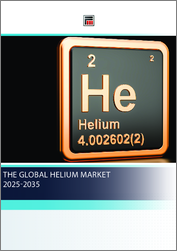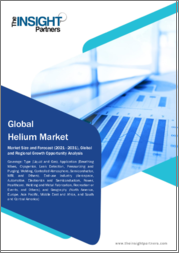
|
시장보고서
상품코드
1610843
헬륨 시장 규모, 점유율, 성장 분석 : 단계별, 용도별, 최종 용도별, 지역별 - 산업 예측(2024-2031년)Helium Market Size, Share, Growth Analysis, By Phase (Breathing Mixes, Cryogenics), By Application, By End-use, By Region - Industry Forecast 2024-2031 |
||||||
헬륨 세계 시장 규모는 2022년 32억 달러로 평가되며, 2023년 33억 4,000만 달러에서 2031년 47억 6,000만 달러로 성장할 것으로 예상되며, 예측 기간(2024-2031년) 동안 4.5%의 CAGR로 성장할 것으로 예상됩니다.
헬륨은 특히 극저온 기술, 항공우주, 의료, 전자 등 여러 산업에서 중요한 역할을 하고 있습니다. 그 용도는 MRI 스캐너 및 NMR 분광기의 초전도 자석 냉각부터 위성 장비 및 아폴로와 같은 과거 우주 임무를 지원하는 것까지 다양합니다. 헬륨의 두 가지 주요 형태인 액체와 기체는 누출 감지, 용접, 제어된 대기 등 다양한 공정에 필수적입니다. 의료 분야에서 헬륨은 천식이나 COPD와 같은 증상에 대한 보조 요법으로, 그리고 다양한 질환의 모니터링 및 진단에 필수적인 강력한 자석을 안정화시켜 MRI 절차를 개선하는 데 도움을 주고 있습니다. 헬륨은 다양한 분야에서 활용되고 있어 첨단 기술 및 의료 진단에 있어 그 중요성이 강조되고 있으며, 이는 중요한 시장 촉진요인으로 작용하고 있습니다.
목차
소개
- 조사 목적
- 조사 범위
- 정의
조사 방법
- 정보 조달
- 2차 데이터와 1차 데이터 방법
- 시장 규모 예측
- 시장 가정과 제한
주요 요약
- 세계 시장 전망
- 공급과 수요 동향 분석
- 부문별 기회 분석
시장 역학과 전망
- 시장 개요
- 시장 규모
- 시장 역학
- 성장 촉진요인과 기회
- 성장 억제요인과 과제
- Porters 분석과 영향
- 경쟁 기업 간의 경쟁 관계
- 대체품의 위협
- 구매자의 교섭력
- 신규 참여업체의 위협
- 공급 기업의 교섭력
주요 시장 인사이트
- 핵심성공요인
- 경쟁 정도
- 주요 투자 기회
- 시장 생태계
- 시장 매력 지수(2023년)
- PESTEL 분석
- 거시경제 지표
- 밸류체인 분석
- 가격 분석
- 기술의 진보
- 규제 상황
- 특허 분석
- 사례 연구
헬륨 시장 규모 : 단계별 & CAGR(2024-2031)
- 시장 개요
- 가스
- 액체
헬륨 시장 규모 : 용도별 & CAGR(2024-2031)
- 시장 개요
- 호흡용 혼합 가스
- 극저온 공학
- 누출 검출
- 가압과 정화
- 용접
- 공기 제어
- 기타 용도
헬륨 시장 규모 : 최종 용도별 & CAGR(2024-2031)
- 시장 개요
- 항공우주 및 방위
- 의료·헬스케어
- 전자·전기
- 원자력
- 금속 가공
- 기타 용도
헬륨 시장 규모 & CAGR(2024-2031)
- 북미
- 미국
- 캐나다
- 유럽
- 영국
- 독일
- 스페인
- 프랑스
- 이탈리아
- 기타 유럽
- 아시아태평양
- 중국
- 인도
- 일본
- 한국
- 기타 아시아태평양
- 라틴아메리카
- 브라질
- 기타 라틴아메리카
- 중동 및 아프리카
- GCC 국가
- 남아프리카공화국
- 기타 중동 및 아프리카
경쟁 정보
- 상위 5개사의 비교
- 주요 기업의 시장 포지셔닝(2023년)
- 주요 시장 기업이 채용한 전략
- 시장의 최근 동향
- 기업의 시장 점유율 분석(2023년)
- 주요 기업 개요
- 기업 개요
- 제품 포트폴리오 분석
- 부문별 점유율 분석
- 매출 전년비 비교(2021-2023)
주요 기업 개요
- Linde Plc.
- Air Products and Chemicals, Inc.
- Linde AG
- Buzwair Industrial Gases Factories
- Praxair, Inc.
- Matheson Tri-Gas Inc.
- Iwatani Corporation
- Gazprom
- ExxonMobil Corporation
- Qatar Petroleum
- Gazprom Export LLC
- Taiyo Nippon Sanso Corporation
- Showa Denko K.K.
- Gulf Cryo Holding
- Australian Helium Pty Ltd.
- PGNiG SA
- Weil Group Resources, LLC
결론과 추천사항
ksm 24.12.23Global Helium Market size was valued at USD 3.2 billion in 2022 and is poised to grow from USD 3.34 billion in 2023 to USD 4.76 billion by 2031, growing at a CAGR of 4.5% during the forecast period (2024-2031).
Helium serves critical roles across multiple industries, notably in cryogenics, aerospace, healthcare, and electronics. Its applications span from cooling superconducting magnets in MRI scanners and NMR spectrometers to supporting satellite instruments and past space missions such as Apollo. The two primary forms of helium, liquid and gaseous, are integral in various processes, including leak detection, welding, and controlled atmospheres. In healthcare, helium is instrumental as an adjunct therapy for conditions like asthma and COPD, enhancing MRI procedures by stabilizing powerful magnets essential for monitoring and diagnosing a wide range of medical conditions. With a diverse utilization landscape, helium's demand across sectors underscores its importance in advanced technology and medical diagnostics, making it a crucial market driver.
Top-down and bottom-up approaches were used to estimate and validate the size of the Global Helium market and to estimate the size of various other dependent submarkets. The research methodology used to estimate the market size includes the following details: The key players in the market were identified through secondary research, and their market shares in the respective regions were determined through primary and secondary research. This entire procedure includes the study of the annual and financial reports of the top market players and extensive interviews for key insights from industry leaders such as CEOs, VPs, directors, and marketing executives. All percentage shares split, and breakdowns were determined using secondary sources and verified through Primary sources. All possible parameters that affect the markets covered in this research study have been accounted for, viewed in extensive detail, verified through primary research, and analyzed to get the final quantitative and qualitative data.
Global Helium Market Segmental Analysis
Global Helium Market is segmented by Phase, Application, End-use, and Region. Based on Phase, the market is segmented into Gas, Liquid. Based on Application, the market is segmented into Breathing Mixes, Cryogenics, Leak Detection, Pressurizing & Puring, Welding, Controlled Atmosphere, Other Applications. Based on End-use, the market is segmented into Aerospace & Defense, Medical & Healthcare, Electronics & Electrical, Nuclear Power, Metal Fabrication, Other End-uses. Based on Region, the market is segmented into North America, Europe, Asia Pacific, Latin America and Middle East & and Africa.
Driver of the Global Helium Market
The global helium market is primarily driven by the growing investments in both conventional and unconventional gas reserves as operators ramp up efforts to meet the surging demand for natural gas. Helium, being a by-product of natural gas extraction, is expected to see a more consistent supply with increased capital expenditures in field development. Additionally, the electronics industry, which relies heavily on semiconductor chips made typically from silicon, has a rising demand for helium due to its exceptional thermal conductivity, inert properties, and ability to regulate the temperature during production. As investments in the electronics sector rise, the demand for helium is anticipated to increase correspondingly, further propelling the global helium market.
Restraints in the Global Helium Market
The global helium market faces significant restraints due to stringent safety regulations surrounding the production and transportation of helium gas. These regulations are in place to address the potential hazards associated with the gas when exposed to high temperatures and pressures, which can render it toxic and dangerous. Consequently, companies operating in this sector must allocate resources toward investing in specialized equipment, methods, and procedures to mitigate risks related to harmful levels and chemical concentrations. As a result, the increased operational costs hinder the ability of businesses to invest in new product development and market expansion, ultimately stifling growth within the industry.
Market Trends of the Global Helium Market
The Global Helium market is witnessing significant growth, driven primarily by increasing demand in the healthcare sector, particularly in North America. As the U.S. healthcare expenditure reached USD 4.1 trillion in 2020, accounting for nearly 20% of GDP, helium's critical role in medical imaging and diagnostic equipment is underscored. This trend is further amplified by advances in healthcare technologies and rising investments in medical infrastructure. Additionally, helium's applications in scientific research and aerospace industries are expanding, cementing its status as a vital resource. Consequently, the market is poised for robust expansion as these sectors continue to flourish.
Table of Contents
Introduction
- Objectives of the Study
- Scope of the Report
- Definitions
Research Methodology
- Information Procurement
- Secondary & Primary Data Methods
- Market Size Estimation
- Market Assumptions & Limitations
Executive Summary
- Global Market Outlook
- Supply & Demand Trend Analysis
- Segmental Opportunity Analysis
Market Dynamics & Outlook
- Market Overview
- Market Size
- Market Dynamics
- Driver & Opportunities
- Restraints & Challenges
- Porters Analysis & Impact
- Competitive rivalry
- Threat of substitute
- Bargaining power of buyers
- Threat of new entrants
- Bargaining power of suppliers
Key Market Insights
- Key Success Factors
- Degree of Competition
- Top Investment Pockets
- Market Ecosystem
- Market Attractiveness Index, 2023
- PESTEL Analysis
- Macro-Economic Indicators
- Value Chain Analysis
- Pricing Analysis
- Technological Advancement
- Regulatory Landscape
- Patent Analysis
- Case Studies
Global Helium Market Size by Phase & CAGR (2024-2031)
- Market Overview
- Gas
- Liquid
Global Helium Market Size by Application & CAGR (2024-2031)
- Market Overview
- Breathing Mixes
- Cryogenics
- Leak Detection
- Pressurizing & Puring
- Welding
- Controlled Atmosphere
- Other Applications
Global Helium Market Size by End-use & CAGR (2024-2031)
- Market Overview
- Aerospace & Defense
- Medical & Healthcare
- Electronics & Electrical
- Nuclear Power
- Metal Fabrication
- Other End-uses
Global Helium Market Size & CAGR (2024-2031)
- North America, (Phase, Application, End-use)
- US
- Canada
- Europe, (Phase, Application, End-use)
- UK
- Germany
- Spain
- France
- Italy
- Rest of Europe
- Asia-Pacific, (Phase, Application, End-use)
- China
- India
- Japan
- South Korea
- Rest of Asia Pacific
- Latin America, (Phase, Application, End-use)
- Brazil
- Rest of Latin America
- Middle East & Africa, (Phase, Application, End-use)
- GCC Countries
- South Africa
- Rest of Middle East & Africa
Competitive Intelligence
- Top 5 Player Comparison
- Market Positioning of Key Players, 2023
- Strategies Adopted by Key Market Players
- Recent Developments in the Market
- Company Market Share Analysis, 2023
- Company Profiles of All Key Players
- Company Details
- Product Portfolio Analysis
- Company's Segmental Share Analysis
- Revenue Y-O-Y Comparison (2021-2023)
Key Company Profiles
- Linde Plc.
- Company Overview
- Business Segment Overview
- Financial Updates
- Key Developments
- Air Products and Chemicals, Inc.
- Company Overview
- Business Segment Overview
- Financial Updates
- Key Developments
- Linde AG
- Company Overview
- Business Segment Overview
- Financial Updates
- Key Developments
- Buzwair Industrial Gases Factories
- Company Overview
- Business Segment Overview
- Financial Updates
- Key Developments
- Praxair, Inc.
- Company Overview
- Business Segment Overview
- Financial Updates
- Key Developments
- Matheson Tri-Gas Inc.
- Company Overview
- Business Segment Overview
- Financial Updates
- Key Developments
- Iwatani Corporation
- Company Overview
- Business Segment Overview
- Financial Updates
- Key Developments
- Gazprom
- Company Overview
- Business Segment Overview
- Financial Updates
- Key Developments
- ExxonMobil Corporation
- Company Overview
- Business Segment Overview
- Financial Updates
- Key Developments
- Qatar Petroleum
- Company Overview
- Business Segment Overview
- Financial Updates
- Key Developments
- Gazprom Export LLC
- Company Overview
- Business Segment Overview
- Financial Updates
- Key Developments
- Taiyo Nippon Sanso Corporation
- Company Overview
- Business Segment Overview
- Financial Updates
- Key Developments
- Showa Denko K.K.
- Company Overview
- Business Segment Overview
- Financial Updates
- Key Developments
- Gulf Cryo Holding
- Company Overview
- Business Segment Overview
- Financial Updates
- Key Developments
- Australian Helium Pty Ltd.
- Company Overview
- Business Segment Overview
- Financial Updates
- Key Developments
- PGNiG SA
- Company Overview
- Business Segment Overview
- Financial Updates
- Key Developments
- Weil Group Resources, LLC
- Company Overview
- Business Segment Overview
- Financial Updates
- Key Developments



















